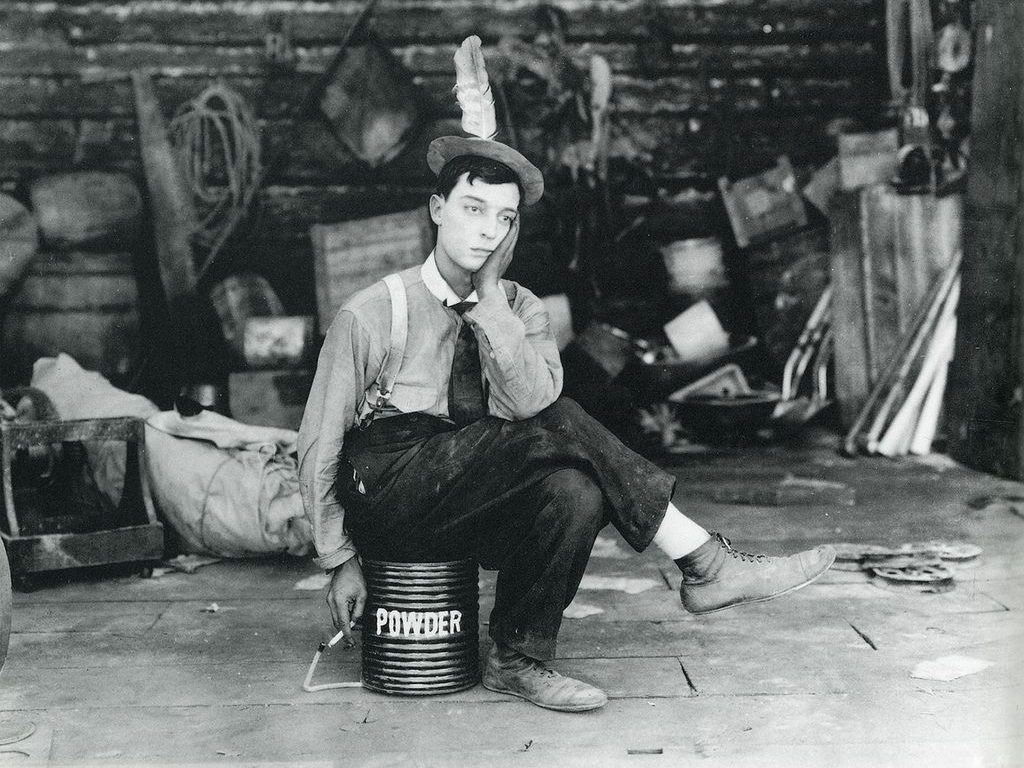THE PALEFACE
Buster Keaton, Eddie Cline (US 1922)
More than any other of the Keaton studio shorts, The Paleface looks forward to the scope, spectacle, and documentary recreation of The General and Our Hospitality. It is moreover a Western whose sympathies are wholly with Native Americans, even though the white hero’s own life is imperiled by them.
Like Our Hospitality, the story is launched with a scene of violent death. The film opens with a landscape of an Indian encampment beside a lake and the title, “In the heart of the West, the Indian of today dwells in simple peace,” only to be followed immediately by “But there came then a group of oil sharks to steal their land.” While the directors of the Western Oil Land Leasing Co. confer decorously in their leather armchairs, one of their agents kills an Indian as he leaves the Government land office proudly bearing the lease for his tribe’s reservation. With the lease in their possession, the Western Oil Land Leasing Co. instantly seek to evict the tribe. Reasonably, the tribe vows to kill the first white man who enters the reservation, and this turns out to be an innocent butterfly collector, with his net and an unmistakable flat hat.
So the story, comedy, and spectacle are launched, as Buster juggles his relationships with this tribe and their rivals – readily distinguishable since, says the title, “They went broke playing strip poker” – and leads them into battle with the oil sharks. The Paleface is the most vivid anticipation of the superhuman physical feats of the great features. An accelerating slide down a 45-degree gravel slope is filmed in one continuous shot and climaxed with a death-defying leap from a cliff into a tree. More remarkable is the crossing of a mountain chasm on a suspension bridge which has lost all but a dozen of the barrel staves that once formed its floor, so that Buster must constantly take the last stave from behind him and set it in front. The final escape from this predicament is a dive down a 60-foot chasm into a mountain stream. Keaton is already in the business of realizing the impossible.
David Robinson
The music Once again… Buster! There’s no way around it, he is and always will be our favourite. The film was chosen by the youngsters, at the end of the theory course at Cinemazero, from a shortlist of four shorts selected from among those not dealt with in previous editions; The Paleface won, by a narrow margin. This extraordinary film gave us the chance to work on the music in a way which particularly interested the first class. We reworked some themes by great composers, including popular quotations to shape them to the narrative. While geographically far removed from Native Americans, the first theme is musically plausible: Béla Bartok’s “Pentatonic Tune”, from the first volume of For Children. Our version particularly emphasizes the percussive element to characterize the tribe which Buster joins. The second theme, “Clowns”, from Dmitri Kabalevsky’s Op. 39 [24 Pieces for Children], ironically underscores the oil sharks, returning, like the first theme, in different variations during the course of the film. The entry of Buster the Butterfly Hunter is a flute duet progressively augmented by the other instruments, and takes as its starting point another children’s piece by Kabalevsky, “Jumping”. After the first attempt to burn our hero alive, we revisit two pieces by Nino Rota, “Salti e giochi” and “L’acrobata” (Jumps and Games, and The Acrobat) [from Sette pezzi difficile per bambini, 1971], to reflect the acceleration of events while avoiding an excessively repetitive pattern. The final theme, representing Buster’s belonging to the tribe and the end of the film, is a Lakota lullaby, which we have arranged to emphasize the nostalgic timbre of the accordion and flutes.
Maria Luisa Sogaro

regia/dir, scen: Buster Keaton, Eddie Cline.
photog: Elgin Lessley.
tech. dir: Fred Gabourie.
cast: Buster Keaton (il viso pallido/The Paleface), Virginia Fox (la fanciulla indiana/Indian Maiden), Joe Roberts (il capo indiano/Indian Chief).
prod: Joseph M. Schenck, Comique Film Corporation, Inc.
dist: First National.
copia/copy: DCP, 24′; did./titles: ENG.
fonte/source: Lobster Films, Paris.


 Italiano
Italiano